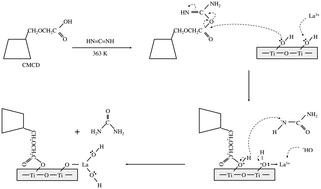Carboxymethyl-β-cyclodextrin functionalization of TiO2 doped with lanthanum: characterization and enhancement of photocatalytic activity
Abstract
This paper proposes the surface functionalization with carboxymethyl-β-cyclodextrin (CMCD) of lanthanum-doped TiO2 nanoparticles, to increase their photocatalytic activity for the degradation of organic molecules. CMCD has the capability to capture these compounds, so increasing their density on the catalyst surface and bringing them into close proximity to the hydroxyl radicals formed. Moreover, the doping with lanthanum can generate superficial defects that capture the formed electrons, so avoiding recombination, and can increase the density of –OH groups or water molecules attached to the surface of the catalyst, potentiating the formation of hydroxyl radicals. From the FT-IR, XPS, DTA and TGA characterizations, it is possible to verify the inclusion of the elements on the TiO2 surface and to propose a mechanism responsible for this lanthanum and CMCD inclusion. The kinetics evaluations show an increase in the degradation rate constants after the inclusion of the organic and inorganic molecules, with 99% degradation of a contaminant after 25 minutes.



 Please wait while we load your content...
Please wait while we load your content...